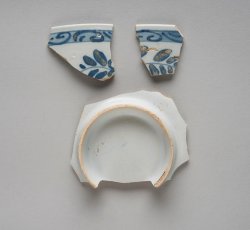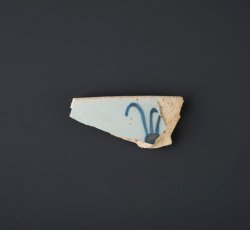Wheel Thrown - Page 13 of 14

Jackfield-type holloware rim.
Refined Earthenware | Object #: 1722532
Slightly everted rim. Possible teabowl or cup.
Explore This Item
Manganese mottled flatware.
Coarse Earthenware | Object #: 1722540
Red, agate paste. Possibly a saucer.
Explore This Item
Blue painted tin-glazed earthenware punch bowl.
Refined Earthenware | Object #: 1722581
These are fragments of a tin-glazed earthenware punchbowl, with a hand painted botanical band adorning the exterior rim. This ware is often referred to by archaeologists as delftware. The white coloration of the glaze was obtained by adding tin-oxide to a lead glaze. Against this white field, d...
Explore This Item
Handpainted polychrome tin-glazed earthenware dish or plate.
Refined Earthenware | Object #: 1722589
This is fragment of a tin-glazed earthenware dish or plate. This ware is often referred to by archaeologists as delftware. Ceramics such as these were produced in numerous locations in both Britain and Holland beginning in the seventeenth-century, though production continued through the end of ...
Explore This Item
Handpainted blue tin-glaze earthenware plate or dish.
Refined Earthenware | Object #: 1722601
This is a fragment of a tin-glazed earthenware dish or plate. This ware is often referred to by archaeologists as delftware. The white coloration of the glaze was obtained by adding tin-oxide to a lead glaze. Against this white field, delft was most often decorated with hand painted cobalt blue...
Explore This Item
Handpainted blue tin-glaze earthenware plate or dish.
Refined Earthenware | Object #: 1722700
This is a fragment of a tin-glazed earthenware dish or plate. This ware is often referred to by archaeologists as delftware. The white coloration of the glaze was obtained by adding tin-oxide to a lead glaze. Against this white field, delft was most often decorated with hand painted cobalt blue...
Explore This Item
Handpainted blue tin-glaze earthenware plate or dish.
Refined Earthenware | Object #: 1722710
This is a fragment encompassing the marly, body and base of a tin-glazed earthenware dish or plate. This ware is often referred to by archaeologists as delftware. The white coloration of the glaze was obtained by adding tin-oxide to a lead glaze. Against this white field, delft was most often d...
Explore This Item
Handpainted blue tin-glaze earthenware tableware.
Refined Earthenware | Object #: 1722729
This is a body fragment of a tin-glazed earthenware unidentified tableware. This ware is often referred to by archaeologists as delftware. The white coloration of the glaze was obtained by adding tin-oxide to a lead glaze. Against this white field, delft was most often decorated with hand paint...
Explore This Item
Handpainted blue tin-glaze earthenware, unidentified.
Refined Earthenware | Object #: 1722733
Likely a tableware or teaware. Tin glaze is fairly white.
Explore This Item
Handpainted blue tin-glaze earthenware teaware, unidentifiable.
Refined Earthenware | Object #: 1722744
Possible saucer.
Explore This Item
Handpainted blue tin-glaze earthenware bowl.
Refined Earthenware | Object #: 1722749
This is a fragment of a tin-glazed earthenware bowl, or possibly small punch bowl, with a hand painted decorative band adorning the rim. This ware is often referred to by archaeologists as delftware. The white coloration of the glaze was obtained by adding tin-oxide to a lead glaze. Against thi...
Explore This Item
Tin-glaze earthenware holloware.
Refined Earthenware | Object #: 1722775
This is a fragment of an undecorated tin-glazed earthenware utilitarian hollow form, such as a chamber pot or large basin. This ware is often referred to by archaeologists as delftware. The white coloration of the glaze was obtained by adding tin-oxide to a lead glaze. Ceramics such as these we...
Explore This Item
Tin-glaze earthenware drug jar/ salve pot.
Refined Earthenware | Object #: 1722797
This is a fragment from the base of a tin-glazed earthenware drug jar. This ware is often referred to by archaeologists as delftware. The white coloration of the glaze was obtained by adding tin-oxide to a lead glaze. Against this white field, delft was most often decorated with hand painted co...
Explore This Item
Tin-glaze earthenware drug jar/ slave pot.
Refined Earthenware | Object #: 1722817
This is a fragment from a slightly flared pedestal base of a tin-glazed earthenware drug jar. This ware is often referred to by archaeologists as delftware. The white coloration of the glaze was obtained by adding tin-oxide to a lead glaze. Against this white field, delft was most often decorat...
Explore This Item
Handpainted blue tin-glaze earthenware plate or dish.
Refined Earthenware | Object #: 1722839
Very similar decoration to object 1722710.
Explore This Item
Westerwald/Rhenish stoneware chamberpot.
Stoneware | Object #: 1723807
This is a fragment of a stoneware chamberpot produced in the Westerwald region of Germany. German stonewares played an important part of the English and colonial ceramic market of the eighteenth century. These vessels were available in a variety of forms but most commonly as jugs, mugs and cham...
Explore This Item
Westerwald/Rhenish 2-quart "GR" stoneware jug.
Stoneware | Object #: 1725014
This is a fragment of a stoneware jug produced in the Westerwald region of Germany. German stonewares played an important part of the English and colonial ceramic market of the eighteenth century. These vessels were available in a variety of forms but most commonly as jugs, mugs and chamberpots...
Explore This Item
Westerwald/Rhenish stoneware tableware.
Stoneware | Object #: 1725091
This is a fragment of a stoneware tableware produced in the Westerwald region of Germany. German stonewares played an important part of the English and colonial ceramic market of the eighteenth century. These vessels were available in a variety of forms but most commonly as jugs, mugs and chamb...
Explore This Item

Scratch blue, White Salt Glaze stoneware hollow vessel.
Stoneware | Object #: 1725145
Measurements taken from largest mended portion.
Explore This Item